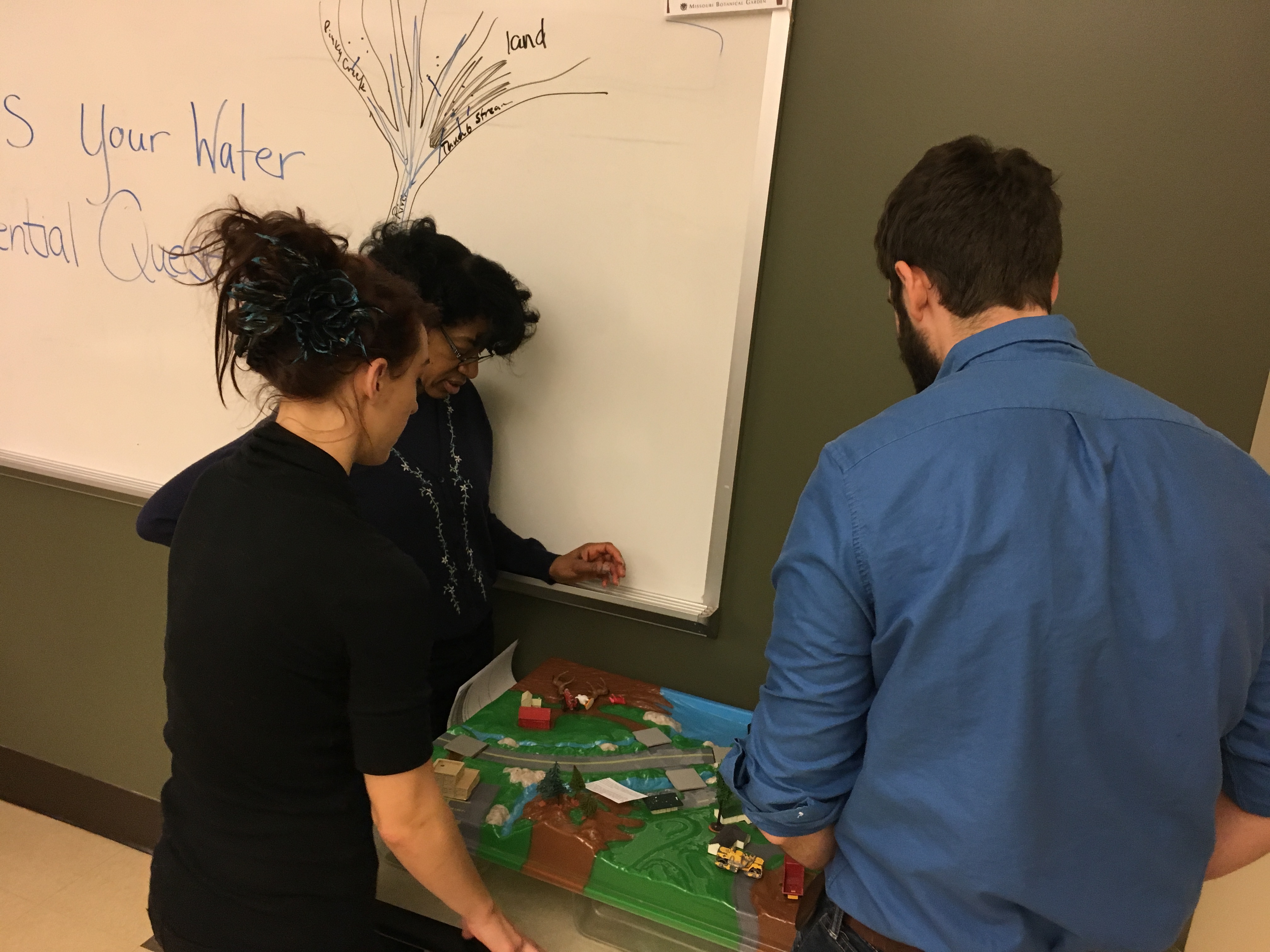With every turn of the faucet and flush of the toilet, we
use and dispose of vast amounts of water every day. We all certainly recognize
that clean water is an essential component of life, but how often do we think
about what happens to the water sent down our drains or the rain falling on our
parking lots and lawns? Thanks to a complex system of treatment plants, pumps
and pipes, our city’s water keeps flowing. Clean water is delivered, dirty
water is taken away and storm water is diverted away from our homes,
businesses, schools, and roads. But, what does this really mean for our
waterways?
On December 9, 2017, Educators from around the St.
Louis region gathered at the EarthWays Center to explore these concepts and
questions during the new Clean Water workshop. This workshop is part of the new
St. Louis Metropolitan Sewer District’s Clean Water partnership with the
EarthWays Center, bridging the gap between schools and local water
infrastructure agencies. Through this
workshop, we hoped to increase understanding of storm water and water quality
issues in our region, build awareness and promote Best Management Practices to
reduce risk, and help support educators in teaching storm water and water
quality issues in their classroom. Educators participated in a six hours of
water exploration, hands-on training, and mapping exercises to become trained
water stewards ready to bring this topic back to their classrooms throughout
the region.
 Kicking off the workshop, educators discovered new ways to
review the water cycle. An important concept when it comes to understanding the
processes behind the way water flows through our community, and how we can have
an impact on that cycle. Through a National Science Foundation video and a fun
song and dance about the Water Cycle, our educators were prepared to dive into
watershed mapping.
Kicking off the workshop, educators discovered new ways to
review the water cycle. An important concept when it comes to understanding the
processes behind the way water flows through our community, and how we can have
an impact on that cycle. Through a National Science Foundation video and a fun
song and dance about the Water Cycle, our educators were prepared to dive into
watershed mapping.

Watershed mapping may sound boring, but how many of you know
what watershed you live in? Neither did our teachers! A watershed is an area of
land that drains all the streams and rainfall to a common outlet such as the Mississippi
River. Watersheds are often separated by elevation, such as ridges and hills.
Our region has many watersheds, and sub watersheds, and even smaller watersheds
to note – and it is important to understand how the water in our homes, in our
neighborhoods, has an impact on these watersheds. Some watersheds you may live or work in
might be: Deer Creek Watershed, Mississippi Watershed, Meramec Watershed,
Missouri Watershed, Cold Creek Watershed, and so many more.
After learning about local watersheds, we worked to explore
how activities in the classroom could connect to water stewardship. The first
teaching tool was the EnviroScape model, a 3D hands-on, interactive model
designed to visually show the impact of non-point water pollution. In addition
to learning about the EnviroScape model, teachers were also taught how to do
water quality testing activities in their classroom. Following this experience,
the teachers got the chance to see some of the Missouri Botanical Garden’s
water capturing features first hand. This included the fantastic bioswales in the parking lot and the unique rainwater harvesting system designed to help capture water at the Climatron.
Finally, the last half of the workshop was dedicated to
action. How do the teachers get students who are water aware to do something
and make a positive change at home or in the school community? With this,
teachers learned how to conduct a Schoolyard Mapping and Assessment. This tool
will help students identify problems, solutions, and give them the opportunity
to become active players in the solution. As a final reflection, educators
created one question that would help guide their future work with water, their
personal water question. These questions captured the importance of studying
water, understanding local waterways, and becoming active stewards to help
ensure the quality and health of our waterways.
-
How can one small person make a difference in
water quality?
-
Where does my water come from? Where does it go
next?
-
How can we make it imperative that we have the
quality and quantity of water we need for the future?
-
How can I help our community and District become
better stewards of the Deer Creek Watershed?
-
Who (or what) is a part of a watershed?
-
How do the processes of the water cycle and
human activity impact the health of waterways in my community?
-
How does water move through my community?
-
How does our community change local and regional
watersheds?
-
Why do humans and animals depend on healthy
watersheds?
-
How can our community work together to protect
our local watersheds?
So, as we look to the new semester, we are excited to
continue working with area educators to promote healthy, clean water systems
through best management practices, stewardship, and education. We look forward
to connecting with more educators with the MSD Clean Water Education program
and bringing this topic to more students throughout our community – remember
everything drains downstream and we’re all downstream from someone!
Interested in learning more about the Clean Water Program?
Click here to learn more about program options and upcoming events.
Upcoming Water Education Workshop:
Thursday,
March 8
4-8 p.m.
Commerce
Bank Center for Science Education Center
Register
Online at: www.msdcleanwater.eventbrite.com
Questions?
Contact us at MSDcleanwater@mobot.org